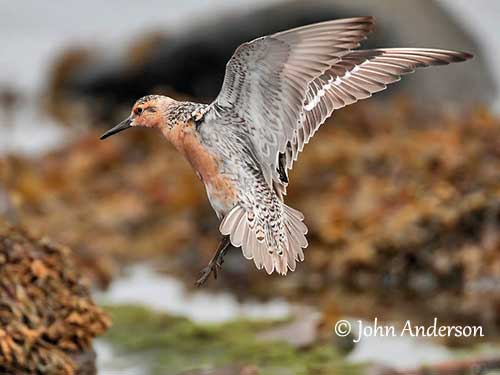
Fr: Bécasseau maubèche
Ang: Red Knot – Knot
All: Knutt
Esp: Correlimos Gordo
Ita: Piovanello maggiore
Nd: Kanoet
Sd: Kustsnäppa
Photographers:
John Anderson
John Anderson Photo Galleries
Steve Garvie
RAINBIRDER Photo galleries & Flickr Rainbirder
Ingo Waschkies
Bird Photography
Text by Nicole Bouglouan
Sources:
HANDBOOK OF THE BIRDS OF THE WORLD Vol 3 by Josep del Hoyo-Andrew Elliott-Jordi Sargatal - Lynx Edicions - ISBN: 8487334202
THE HANDBOOK OF BIRD IDENTIFICATION FOR EUROPE AND THE WESTERN PALEARCTIC by Mark Beaman, Steve Madge - C. Helm - ISBN: 0713639601
SHOREBIRDS by Peter Hayman, John Marchant and Tony Prater – Christopher Helm – 1986 – ISBN: 0747014035
GUIDE DES LIMICOLES de D. Taylor - Delachaux et Niestlé - ISBN : 2603014080
All About Birds (Cornell Lab of Ornithology)
What Bird-The ultimate Bird Guide (Mitchell Waite)
Wikipedia, the free encyclopaedia
ABC Science - Shrinking shorebirds pay the price for Arctic warming when they reach the tropics
National Geographic - Can Long-Distance Migrating Shorebird Survive?
Red Knot
Calidris canutus
Charadriiformes Order – Scolopacidae Family
INTRODUCTION :
The Red Knot is a dull typical Calidris with greyish plumage in winter. However, during the breeding season, its reddish to deep chestnut plumage makes it very conspicuous.
This species is a long-distance migrant with usually few stopover sites. It breeds in the Arctic Circle tundra and nests on the ground near water.
It spends the winter along the coasts around the world, from S South America and South Africa to Australia. Every year, it travels about 15,000 kilometres from the Arctic to the southernmost regions of its wintering areas. Six subspecies are recognized throughout the wide range.
The Red Knot is threatened by habitat loss, overfishing, pollution, disturbance and illegal hunting (in New Zealand). The species is currently classified as Near Threatened.

DESCRIPTION OF THE BIRD:
Biometrics:
Length: 23-25 cm
Wingspan: 45-54 cm
Weight: 85-220 g
The Red Knot is a stocky shorebird. In breeding plumage, face and underparts are brick-red. Forehead, crown and hindneck show brownish mottling. The upperparts are blackish with scaled pattern made by the pale and chestnut edges and patches of the feathers.
The long, thick, straight bill is black. The eyes are dark brown. Legs and feet are greyish-black.
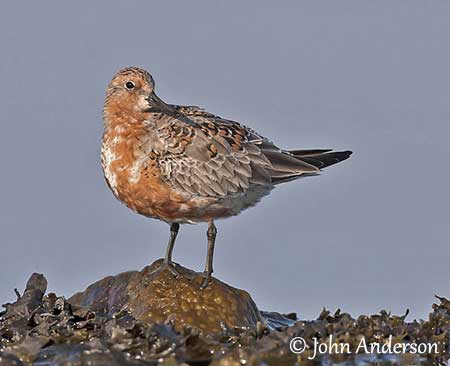
The non-breeding adult has pale grey upperparts, with narrow white edges to feathers. On the wings, the primaries are blackish. The underparts are white with light grey markings on breast and flanks. Legs and feet are dull greenish-yellow.
The head is greyish with whitish cheeks and eyebrows and dark lores.
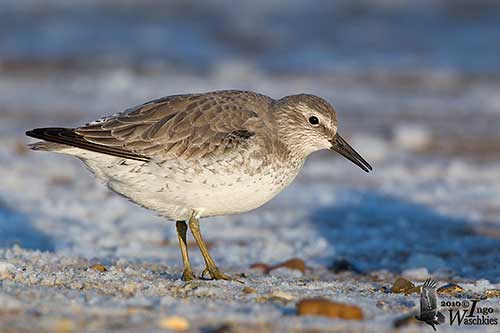
The juvenile resembles adult in winter. The breast is washed pale buff. The upperparts are scaled grey and white with buffy wash on head and mantle, whereas wing-coverts and scapulars have buff fringes and dark subterminal lines.

SUBSPECIES AND RANGE:
The Red Knot has six subspecies.
C.c. canutus (described above) breeds in CN Siberia, in Taymyr Peninsula and possible Yakutia. It winters in W and S Africa and S Asia.
C.c. persmai breeds in New Siberian Islands. It winters in NW Australia.
C.c. rogersi breeds on Chukotskiy Peninsula and possibly in areas farther W. It winters in Australasia. This race is paler with more white on lower belly.
C.c. roselaari breeds on Wrangel and NW Alaska. It probably winters on the coasts of SE USA (Florida), S Panama and N Venezuela. This one has more coloured belly and undertail-coverts.
C.c. rufa breeds in Canadian low Arctic. It winters on the coasts of NE and S South America. This race is paler below with more white on lower belly.
C.c. islandica breeds on islands of Canadian high Arctic and N Greenland. It winters in W Europe. It is paler below with yellowish fringes on the upperparts.
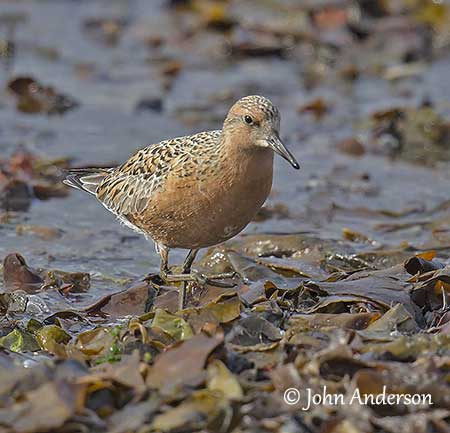
HABITAT:
The Red Knot breeds on open, stony tundra, on rather high barren areas, but usually near water, ponds or streams, and often near the coasts. Outside breeding season, it frequents tidal flats, estuaries with firm mud or sand, sandy beaches, bays, lagoons and harbours. It is strictly coastal in winter.
CALLS AND SONGS: SOUNDS BY XENO-CANTO
The Red Knot is not very vocal. The contact call is a low, soft, nasal “knutt” and variants, heard from flying flocks and feeding birds. When flushed, it gives a sudden “kikkik”. During displays, the male utters a fluty, melodious song “poor-me”.
BEHAVIOUR IN THE WILD:
The Red Knot feeds on molluscs, insects, spiders, crustaceans, snails and worms, and takes occasionally seeds and green vegetation.
During winter and migration, it feeds mostly on invertebrates found in the mud of the intertidal zone, including small molluscs, marine worms and crustaceans. It feeds mostly on insects (flies) on the breeding grounds. However, in the early breeding season, when insects are scarce, it feeds on plant material such as shoots, buds, leaves and seeds.
The Red Knot forages by probing into the mud with the bill. Like numerous Scolopacidae, it finds its food by touch with the bill tip. It also picks items from dry sand and tundra, and finds the prey by sight.
It is highly gregarious and can be seen in large flocks of 300/10,000 birds, especially at roosting sites.
It is both diurnal and nocturnal feeder.
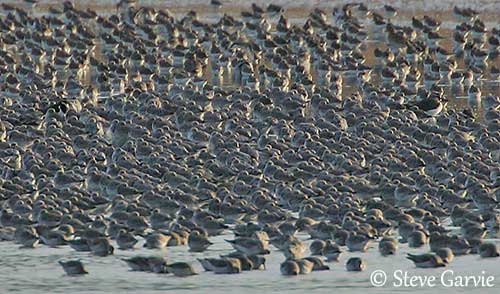
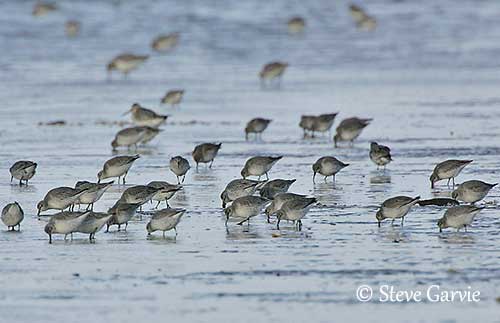
The Red Knot is monogamous and breeds solitary between June and August. The courtship displays involve a high circling flight, then hovering on still or quivering wings, before ending in a rapid tumbling fall to land. This display is accompanied by mellow whistles. The female may sometimes fly with its mate around their territory.
Some displays are performed on the ground by the male, during which wings and tail are upraised.
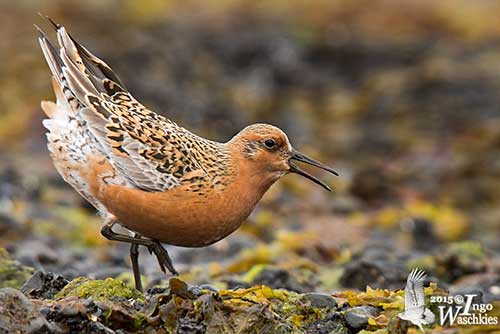
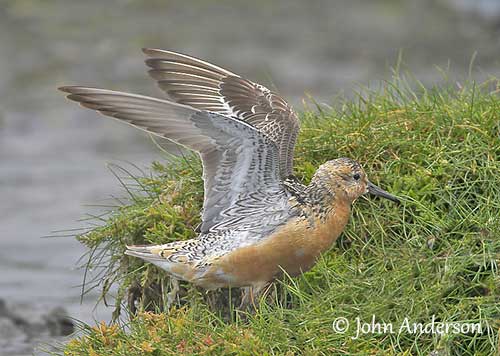
The Red Knot is a long-distance migrant and performs long flights between the staging posts. It usually follows the coasts, but some routes are overland, such as over W Africa and C Brazil. It is vagrant to many oceanic islands such as Madeira and Cape Verde Islands in the Atlantic Ocean, and Chatham and Macquarie Islands in S Pacific Ocean.
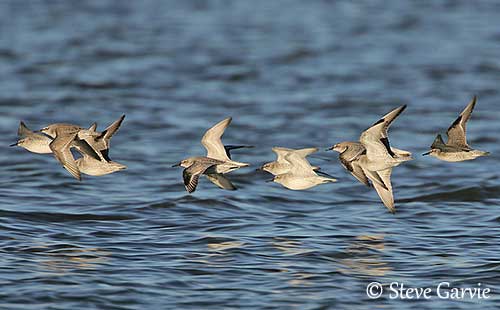
The Red Knot is known for the swirling aerial manoeuvres of the flying flocks. These flocks are usually ovoid, but they become flatter when they come near the ground. They migrate in V-shaped formation or in lines. The flight is swift and direct with rapid wingbeats.
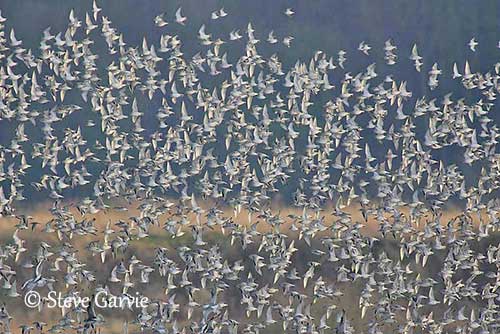
REPRODUCTION OF THIS SPECIES:
The breeding season takes place in June/August, with the laying in June.
The Red Knot nests on the ground in open vegetated tundra or stone ridge usually close to clump of vegetation and near water. The nest is a shallow scrape with a lining of vegetation, usually leaves, lichen and moss.
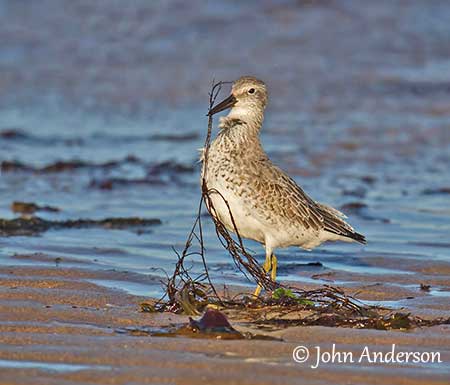
The female lays 3-4 buff-coloured eggs with brown markings. Both adults share the incubation during 3 weeks, and usually, the female disappears after hatching and the male tends the brood alone. The chicks have cryptic down with mottled upperparts, making them well-camouflaged on the ground. They fledge 18-20 days after hatching. They are sexually mature at 2-3 years old.
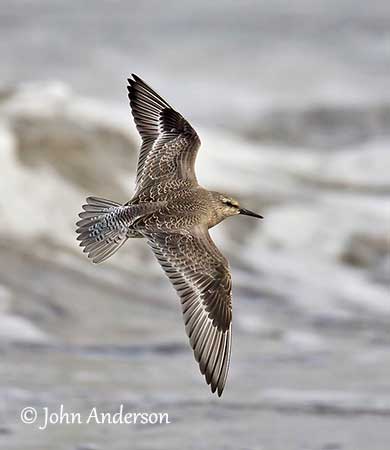
PROTECTION / THREATS / STATUS:
The Red Knot is vulnerable to habitat loss, with the loss of intertidal stopover habitats in the Yellow Sea region, through urban, industrial and agricultural expansion.
The species is also threatened by over-exploitation of shellfish, pollution, aquaculture operations, damming of rivers and invasive grasses on mudflats, reducing prey availability.
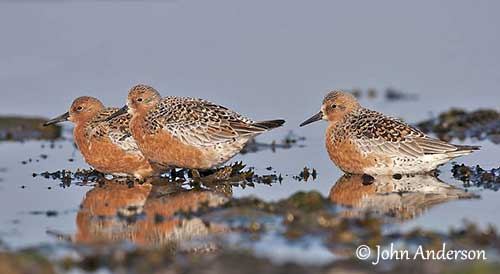
Human disturbance and illegal hunting, with in addition the effects of climate change, threaten the population of the Red Knot.
The global population is estimated to number 891,000/979,000 individuals (Wetlands International 2015). This population is still decreasing.
The Red Knot is currently classified as Near Threatened.
